Resellos on dos caritas - Central Mexico
Durango - Jefatura de Hacienda
There were two different offices that revalidated notes in Durango. However, on 30 November 1914 the Jefatura de Hacienda, whilst restamping sábanas, returned a $5 Series C to the Recaudador de Contribuciones in Cuencamé without revalidation because it did not need it as ‘there were no forgeries in existence’ADUR, Sección de Hacienda p103.
Durango – Administración Principal del Timbre
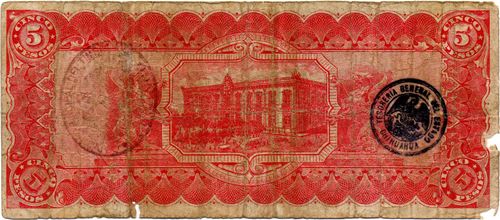
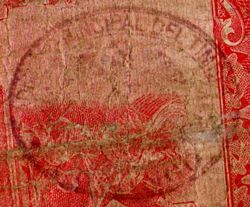 Two different seals are known. ‘ADMINISTRACION PRINCIPAL DEL TIMBRE - DURANGO’
Two different seals are known. ‘ADMINISTRACION PRINCIPAL DEL TIMBRE - DURANGO’
and ‘Admon. Pral. del Timbre. Durango. Este billete es de circulacion forzosa por ser autentico'.
This was in use by March 1915 since on 8 March Villa informed the Jefe de Hacienda that he had ordered the authorities to continue restamping all Chihuahua notes in the Administración del Timbre whilst cancelling any that turned out to be forgeriesVida Nueva, 9 March 1915. The branch was situated on Avenida Juárez.
Durango – Banco del Estado de Chihuahua
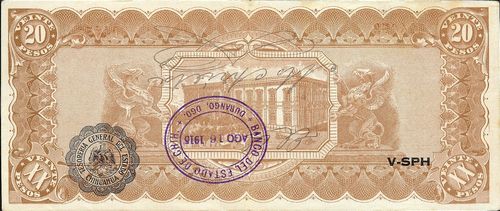
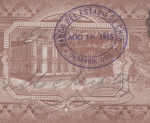 a 38mm violet oval with ‘BANCO DEL ESTADO DE CHIH. - DURANGO, DGO’ and date and with handwritten signature of M. Arrieta. This resello is known on a limited range of control letters (V-SPH, Y-NTV, Y-ZLM. Z-BMV, JLH-A and CAQ-K) on usually uncirculated $20 notes with the date of 16 August 1915 on the stamp.
a 38mm violet oval with ‘BANCO DEL ESTADO DE CHIH. - DURANGO, DGO’ and date and with handwritten signature of M. Arrieta. This resello is known on a limited range of control letters (V-SPH, Y-NTV, Y-ZLM. Z-BMV, JLH-A and CAQ-K) on usually uncirculated $20 notes with the date of 16 August 1915 on the stamp.
This branch of the bank was opened on 24 May 1915Vida Nueva, 26 May 1915. On 14 July 1915 governor Saravia acknowleged that he had received from the Durango branch of the Banco del Estado de Chihuahua $20,000 that Villa had ordered to be sent to pay the troopsADUR, Fondo Secretaría General de Gobierno, Sección Siglo XIX, Serie Correspondencia, Subserie Revolución, gaveta 6, nombre 88. Presumably this was 1,000 $20 notes, a pretty useless denomination with which to pay ordinary soldiers.
Aguascalientes – Secretaría de Gobierno
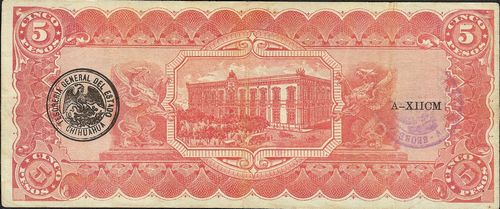
A round 31mm violet ‘SECRETARIA DE GOBIERNO - AGUASCALIENTES’ with eagle in centre.
On 11 November 1914 an Aguascalientes and a Mexico City newspaper reported that Villa had launched a new issue in Zacatecas, which had reached Aguascalientes and was causing concernEl Demócrata, 11 November 1914; El Sol, 11 November 1914. As there was no such issue, these might be references to the arrival of dos caritas in Aguascalientes, brought from ZacatecasHowever, earlier, on 6 October 1914, Marion Letchner, the U.S. consul in Chihuahua, had reported that Villa has ordered printed and dispatched from Chihuahua to Zacatecas immediately with all haste possible one million Mexican dollars under conditions suggesting its use in [suborning?] participants in the approaching Aguascalientes convention (SD papers, 812.5157/63 telegram to State Department) and this might be the source of the news item.
From 20 February 1915 holders of dos caritas could have them checked in the Tesorería General del Estado, though the office was going to concentrate on the sábanasPeriódico Oficial, 22 February 1915 and six days later dos caritas were being given out in exchange for sábanas in an office set up in a branch of the Banco de ZacatecasPeriódico Oficial, 27 February 1915.
By March 1915 the dos caritas were being refused by post offices and railway stations, in accordance, they claimed, with superior orders. The governor, Benito Díaz, told the state offices under his authority to accept them and asked Francisco Escudero, the head of Hacienda y Fomento in Chihuahua, to instruct the federal offices to do the same.
The Carrancistas took Aguascalientes on 10 July 1915.
San Luis Potosí – Prefectura Regional
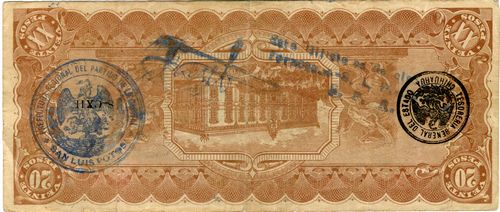
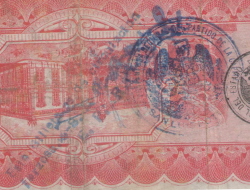 A blue circular rubber stamp with the legend ‘PREFECTURA REGIONAL DEL PARTIDO DE LA CAPITAL - SAN LUIS POTOSI’ and an eagle in the centre, together with a line inscription ‘Este Billete es de circulacion forzosa. S.L.P.....1915 J. Rangel’
A blue circular rubber stamp with the legend ‘PREFECTURA REGIONAL DEL PARTIDO DE LA CAPITAL - SAN LUIS POTOSI’ and an eagle in the centre, together with a line inscription ‘Este Billete es de circulacion forzosa. S.L.P.....1915 J. Rangel’
The Constitutionalists captured San Luis Potosí in July 1914. On 24 August the Prefectura Regional de la Capital, Coronel Ignacio Ramos, reminded the public that the two Villista issues were of forced circulation. The notes would be exchanged for other Constitutionalist currency at a later date if the authorities decided to withdraw them, but the public would be given sufficient noticePeriódico Oficial, 27 August 1914. However, Ramos made no mention of revalidation.
At the beginning of 1915 former President Eulalio Gutiérrez broke with the Conventionists, took part of the treasury and tried to install a national government in San Luis Potosí, with the support of Aguirre Benavides and the neighbouring governor of Hidalgo. On 1 February General Tomás Urbina and his Villistas took the city peacefully and General Emiliano Saravia was named governor.
By March the Prefecto Regional, A. B. Cortes, was working with the Jefatura de Hacienda on the matter of currency. On 3 March the Jefatura de Hacienda’s offices (in the Palacio Federal) began exchanging the sábanas (of five pesos and abovePeriódico Oficial, 10 March 1915) and checking the dos caritasPeriódico Oficial, 6 March 1915. The offices were open from 10 a.m. until 1 p.m.. On 11 March an office (for exchange and revision) was established in the basement of the Jefatura de Armas (in the old Banco de San Luis), under the direct control of the Tesorería General del Estado de ChihuahuaPeriódico Oficial, 13 March 1915.
The resello appears to imply that J. Rangel was E(l) P(refecto) R(egional) but a Juan Rangel had been a porter (conserje) in the Sección de Correspondencia y Archivo of the Tesorería General of Chihuahua in September 1914AMC and might have been the expert sent from Chihuahua.
The Carrancistas occupied San Luis Potosí in July 1915.
Guanajuato - Departamento de la Capital de Guanajuato
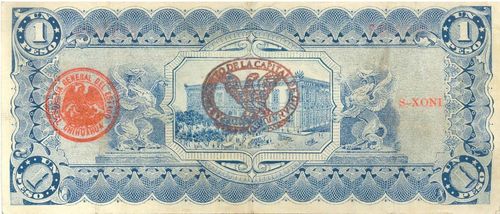
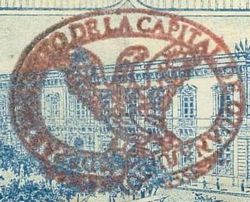
This resello is considered counterfeit, and certainly is not part of a revalidation exercise, particularly since it is applied to a $1 note.
There are no direct references to resellos in Guanajuato but on 21 August 1914 the Gobernador and Comandante Militar, General Pablo A. de la Garza wrote to the Jefe de Hacienda to list the paper money that was of forced circulation, including the dos caritasCrispín Espinosa, Efemérides Guanajuatenses, Guanajuato, 1920. Similar decrees followed: for instance, on 1 September 1914 Enrique Campacos, the Administrador General de Rentas, listed the notes that his office would accept, including the sábanas, dos caritas and Ejército ConstitucionalistaEl Observador, 7 September 1914.
Tulancingo – Jefatura de Armas
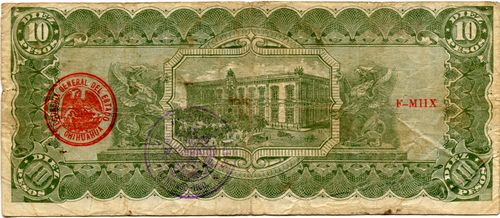
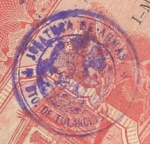 A round 34mm violet seal with ‘JEFATURA DE ARMAS, DTO DE TULANCINGO, HGO’ and eagle in centre
A round 34mm violet seal with ‘JEFATURA DE ARMAS, DTO DE TULANCINGO, HGO’ and eagle in centre
Tulancingo is the second-largest city in the state of Hidalgo.
It was captured by Convention forces under General J. Méndez on 2 May 1915.
[ ] – Oficina Reselladora
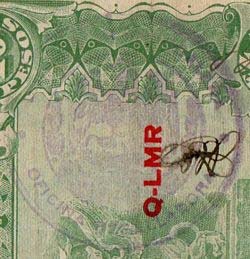
[ ] – 'F.C. de Mexico'
Zacatlán – Comandancia Militar
‘Comandancia Militar, Zacatlan, Pue.’
Zacatlán is a city in the northern part of the state of Puebla.
